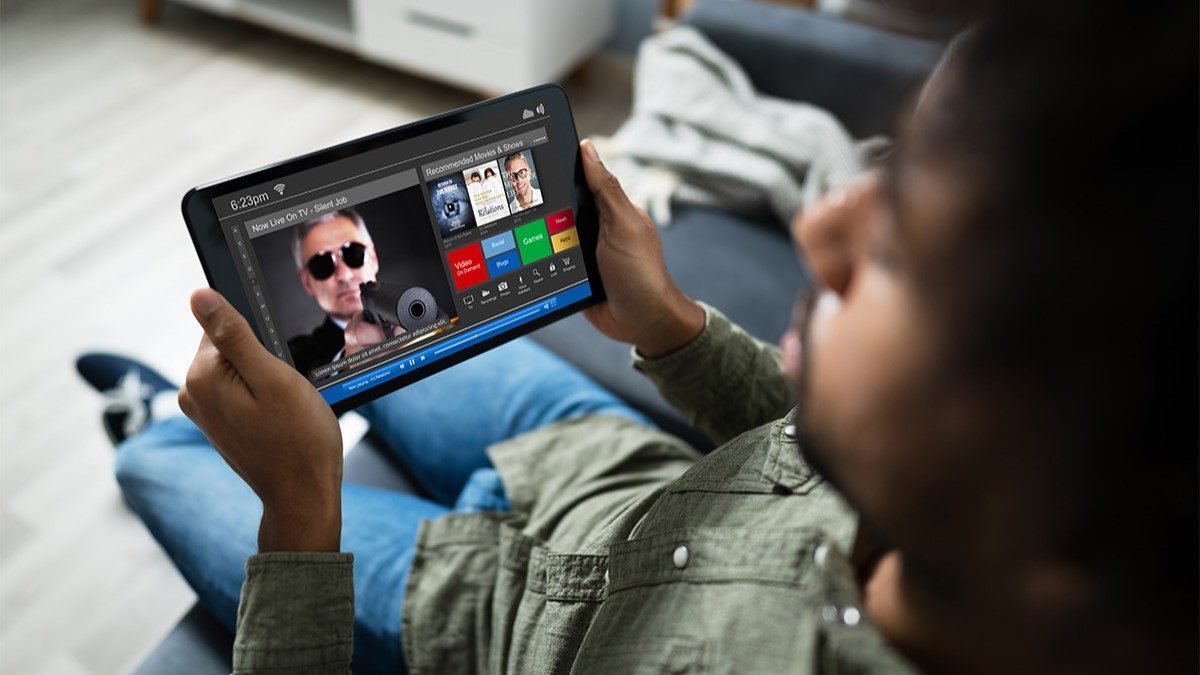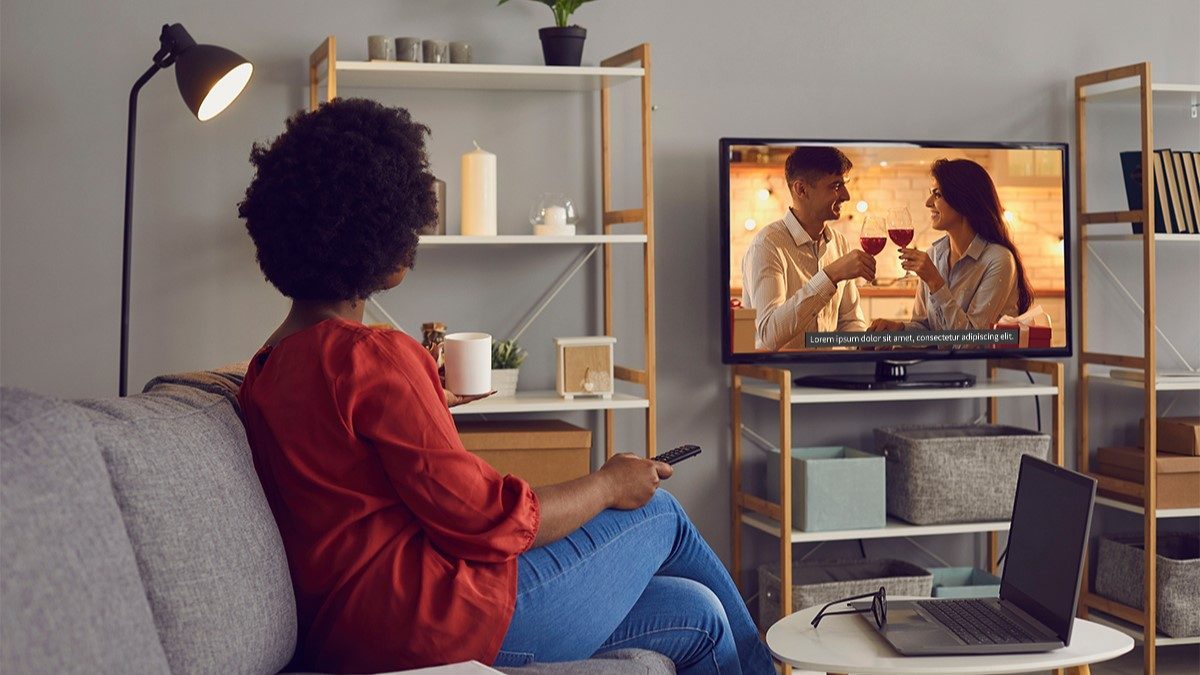Closed captions and subtitles show the dialogue and/or audio portion of a program as text on your TV, computer, or phone screen. They’re an important usability aid whether a viewer is hearing, hard-of-hearing, or Deaf. A 2022 survey found that 50% of Americans regularly use subtitles when watching content.1
The Federal Communications Commission (FCC) requires closed captioning on TV, but how do you turn on closed captioning for streaming services and devices?2 It’s not hard. And, if you’re in a typical American household, you watch 5.4 streaming services a month. So, you may need to set up captions multiple times.3
In this guide, we show you how to turn captions on across the most popular streaming services, Pay TV providers, and streaming devices.
Once you get captions set up, you won’t miss a moment of dialogue even if you’re hard-of-hearing or Deaf, or when the dog barks, the kids holler, or you need to jump on a phone call.
Read on to find out how to turn captions on or jump straight to your provider or service.
Netflix | Amazon Prime Video | Hulu | Disney+ | HBO Max | Paramount+ | Peacock | Apple TV+ | YouTube | Xfinity | Spectrum | Cox | DirectTV | DISH | Amazon Firestick | Chromecast | Roku | Apple TV | Samsung TV Plus
A Note on Closed Captions, Subtitles for the Deaf and Hard-of-Hearing, and Subtitles
- Closed captions show words on the screen for spoken dialogue, intention, and tone, as well as descriptions of unspoken sounds, which creates full context for the viewer.
- Subtitles simply translate and show spoken dialogue and are targeted at users watching content in a language other than their native language. They are a good alternative when full closed captions are unavailable.
- Subtitles for the deaf and hard of hearing (SDH) combine subtitles and closed captions. SDH is often available when closed captions aren’t.
Now let’s dive in to how to turn on closed captions on TV shows and streamed content.
How to Get Closed Captions on TV Video Streaming Services
Turn On Captioning for Netflix
Getting started with Netflix closed captions or subtitles on any device is easy. Simply follow the steps below.
Hint: To turn captions on for all shows, start with an adult profile (not a kid’s profile) and pick a show with a maturity rating for teens and older. Then watch for at least 2 to 3 minutes to save your preferences for future shows.
For mobile phone, tablets, and Mac or PC computers:
- Open Netflix.
- Pick a show to watch.
- Push play.
- Tap or click on the screen.
- Select Audio & Subtitles.
- Turn on subtitles or English (CC) for closed captioning.
For smart TVs, Blu-ray players, or gaming system, and streaming media player:
- Open Netflix.
- Pick a show to watch.
- Push play.
- Press your remote’s up or down arrow to select Audio & Subtitles.
- Turn captions on or off and select your preferred language.
On Apple TVs:
- Open Netflix.
- Pick a show to watch.
- Push play.
- Swipe down on the remote (Apple TV 4 and 4K) or hold down the remote’s center button (Apple TV 2 or 3) to select Audio & Subtitles.
- Turn captions on or off and select your preferred language.
Netflix offers up to seven language options for subtitles and closed captions. They depend on your location and language settings. If you don’t see your preferred language, subtitles or closed captioning isn’t available for that language yet.
Learn more about captions, profiles, language options, and more in the Netflix Help Center.
Using Amazon Prime Video with Captions
Amazon Prime Video is Amazon’s on-demand streaming service. Up to 66% of U.S. households subscribe.5 All Amazon Prime members get free access to Amazon Prime Video. Available content includes movies, TV shows, sporting events, and the ability to combine Prime Video with other popular streaming services, such as HBO Max, Paramount+, and Discovery+.
Adding captions or subtitles to Prime Video is quick and simple from the Prime app.
First select the language you want to see captions or subtitles in:
- On a show, select the Overview screen.
- Select Subtitles.
- If subtitles are available in your language, you’ll see the Closed Caption or Subtitles symbol.
To see subtitles or closed captions for a show that supports them:
- Open the Amazon Prime Video app.
- Select a show.
- Push play.
- On the playback menu, select the Closed Caption or Subtitles symbol.
- You may need to hit the enter button on your remote or controller to access the playback menu.
- Turn subtitles on (or off) and select a language.
Amazon Prime Video and many other services give you the added benefit of letting you modify the size and color of captions and subtitles. You can do that under the Subtitles Settings menu.
Learn more in the Amazon Prime help center.
Access Closed Captions for Hulu
Hulu is another favorite streaming service of U.S. households with more than 40 million subscribers.6
To use subtitles or closed captions on Hulu-supported TV or TV-connected devices where available, simply:
- Select a show.
- Push play.
- Press the up button or swipe down on your remote to open the playback bar.
- Press or swipe up to open the Settings menu.
- Under Captions & Subtitles, select On or Off.
On supported mobile devices:
- Select a show.
- Push play.
- Under Subtitles & Captions, tap Auto, On, or Off.
- Tap the X to save your preferences and return to your show.
On supported mobile devices:
- Select a show.
- Push play.
- Click to enter the Subtitles & Captions menu.
- Choose a language for your captions or select On.
A nice benefit of subtitles and closed captions on Hulu is that you can choose English or Spanish, when available, format captions, and each profile can manage captions independently. They can also be turned on and off based on the content being watched.
Visit the Hulu Help Center to find out how to choose a language and formatting for your captions or subtitles.
Disney+ with Closed Captions
Disney+ is every streamer’s one-stop shop for shows from Disney, Pixar, Marvel, Star Wars, and National Geographic. It has 152 million subscribers around the globe.7
To keep up with its global audience, Disney+ supports closed captions and subtitles in up to 28 languages.


Setting up subtitles and closed captions on Disney+ is straightforward. Here how to do so on any device:
- Select a show.
- Push play.
- Open the Audio & Subtitles menu icon (usually located in the top right corner of the screen. Actual location depends on the device).
- Choose the language you want to see captions in.
It’s that simple to watch Disney+ content with closed captions.
You can also format captions and subtitles for Disney+ on a variety of devices, including those running iOS and Android, Smart TV, streaming devices, the web, and Xbox or PlayStation.
Subtitles with HBO Max
About 73.8 million people worldwide subscribe to HBO and HBO Max.8
Today, subscribers can only access closed captioning in English. And turning captions on for HBO Max varies slightly based on the device you’re using. For details on your specific device, visit the HBO Max Help Center. Here’s the basic process.
- Start watching a show,
- Click the screen or the Select button on your remote.
- Select the Audio and Subtitles icon.
- Choose English CC.
- Click X or press the back button to save your changes.
If you want to change the captioning style, choose your profile, then Settings, choose Closed Captions and/or Manage Preferences.
Paramount+ Captions
Paramount+ supports closed captions. Turning them on varies depending on the device you’re watching Paramount+ content on. Regardless of device, you turn them on through the Accessibility menu. Look for Subtitles and Captioning, Subtitles, Captions, Closed Caption, or Caption Mode to turn closed captioning on. For instructions for your specific device, visit the Paramount+ Help Center.
How to Use Subtitles with Peacock
Peacock is NBC’s streaming app. It offers free and paid plans. More than 20 million people watch Peacock each month.9
You can access subtitles on Peacock, but not true closed captions. Find out how to use subtitles with Peacock.

Apple TV+ with Subtitles
Apple TV+ is Apple’s streaming service. You can watch it on Apple devices, the web, and through other services and streaming devices.
Apple TV+ supports only subtitles for individual shows if available. You can turn closed captions and SDH on by default and see them if/when available for specific content. Learn how in the Apple Support Center.
Seeing Captions on YouTube and YouTube TV
You might think of YouTube as simply a repository for videos of any and every kind, but it also offers YouTube TV, a popular paid TV streaming service for more than 100 channels, including ABC, CBS, NBC, ESPN, and AMC.
Seeing closed captions on YouTube and YouTube TV content depends on the availability of captions on the individual video or channel you watch.

Turn Captions on for YouTube
YouTube captions and subtitles are set up the same way, regardless of the device you watch on. If you watch from a YouTube account you created, captions will be in the preferred language you select for your account.On your computer:
- Select a video.
- If the CC icon shows in the lower right corner, captions are available. Click the icon to turn captions on.
On an Android or IOS device:
- Select a video.
- Tap the video player.
- If the CC icon shows, captions are available. Tap the icon to turn captions on.
On TVs and game consoles:
- Select and play a video.
- Hit Pause.
- Tap the CC icon.
- Choose a language for captions.
- Select Caption Style.
- Customize settings if desired.
To customize caption format and language for YouTube videos, visit the YouTube Help center.
Turn Captions on for YouTube TV
YouTube TV is an app. Turning captions on for YouTube TV is similar to turning them on for YouTube.
On your computer or Android device:
- Select a video.
- Select Play.
- If the CC icon shows in the progress bar or under More in the upper right corner, captions are available. Click the icon to turn them on.
On an IOS device:
- Select a video.
- Select Play.
- If the CC icon shows, captions are available. Select the icon to turn them on.
If you watch on-demand or recorded videos on YouTube TV that offer captions, you can format them; for live TV, you can’t. To learn more, visit the YouTube TV Help center.
Pay TV over Cable Captioning
Cable isn’t as popular as streaming services: just 56% of U.S. households have a cable box compared to 78% who subscribe to Netflix, Amazon Prime Video, or Disney+.9 But 56% of U.S. households is nothing to sneeze at.
If you get Pay TV by cable through Xfinity, Spectrum, or Cox, here’s how to turn closed captions on and off, as well as how to customize them to your preferences.
Accessing Captions on Xfinity
If you use Xfinity from Comcast for your Pay TV services, you can access closed captioning with the Voice Remote, during a program, or through the XI Accessibility Setting menu.
With your Voice Remote:
- Hold down the microphone button.
- Say “Closed Captions” or “Captions.”
During a program:
- See accessibility setting for the program under the transport bar or press the down arrow or the OK button to access the accessibility buttons on your X1 remote.
- Press the left arrow button to select Closed Captioning (CC).
Using the X1 Accessibility Setting menu:
- Push the B button on your remote to access Accessibility Settings.
- Press OK to turn captions on or off.
- To customize your Xfinity closed caption options—such as size and color—go to Closed Captioning Options.
Learn more and see how to change the font size, color, and formatting of captions in the Xfinity Support center.
Setting up Closed Captions on Spectrum
Spectrum from Charter is the second largest cable TV provider in the U.S.
Follow these simple steps to turn captions on or off for Spectrum content.
- Press Menu on your remote control.
- Use the arrow buttons to go to Settings & Support.
- Press OK/Select.
- From the highlighted Accessibility section, choose:
-
- Closed Captioning to turn captions on or off.
- Closed Captioning Settings to choose the style and color for your captions.
- Highlight Save and press OK/Select to save your changes.
Learn more and deep-dive into Spectrum’s closed captioning settings in the Spectrum Support center.
Watching Cox Cable TV Shows with Captions
Cox Contour TV is a cable service from Cox Enterprises. Cox also offers a streaming device that works with any TV and provides access to Netflix, Prime Video, Hulu, Disney+ and other streaming services.
To turn captions on for your Cox Contour TV or Stream Player, on your Cox remote control:
- Turn your TV on.
- Press the CONTOUR button to see the Main Menu.
- Highlight Settings (the gear icon), press OK to access the Settings menu.
- Highlight Device Settings, press OK.
- Do one of the following:
-
- Use the voice command, “Closed Caption” to turn captioning on or off.
- Press the down arrow to display the playback control bar and select the closed captioning shortcut.
- Go to the Accessibility Menu by pressing the B button, highlight Settings, and scroll down to Accessibility Settings.
You can adjust the formatting of closed captions on your Cox services. Find out how in the Cox Support center.
Seeing Captions with Others Cable TV Providers
If you’re not using one of the providers already covered, here are a few more Pay TV providers and how to set up captions through their services.
Optimum from Altice USA (formerly Suddenlink)
Accessing captions with Optimum cable service depends on the device you’re using. Find your device and see how to turn on captions on Optimum’s website.
Mediacom
Mediacom lets you turn closed captioning on or off for all shows or a single show while you’re watching. Just press the Info icon and select On or Off for Closed Captioning. Mediacom also lets you choose how closed captions are display. Learn more in the Mediacom Answer Center.
Getting Captions with Pay TV by Satellite
Turning on closed captions on subtitles on DirecTV or DISH is simple and straightforward.
Turn On Closed Captioning for DirectTV
DirectTV is an AT&T brand. It’s still used by many subscribers, but use is declining. It lost 300,000 subscribers in the first 3 months of 2022 alone.10 Even so, it’s still the leading satellite choice for Pay TV.
If DirectTV is your go-to choice for watching content, it’s easy to turn subtitles on and off. Simply follow these steps.
- Press the INFO button on your remote.
- Scroll to the right and select CC.
- Select Closed Captioning to turn captions on or off.
You can personalize DirectTV caption options too.
Watching DISH Content with Closed Captions
DISH, from the DISH Network, is the second most popular satellite TV provider in the U.S. DISH makes enabling captions a simple two-step process.10 Just:
- Press the red or Options button on your remote twice.
- Select the CC icon to turn on or off closed captioning.
You can also adjust your caption settings and set up other usability options, including audio description, screen magnification, and text to speech through the DISH Accessibility Settings menu.
Using Captions on Streaming Devices
A streaming device, aka streaming media player, is a physical piece of hardware. It connects to your TV through the HDMI port and uses your internet connection to stream online content to your TV, making it possible to access all your favorite services in one location.
Here’s how to turn captions on and off for with streaming devices.
Captions for Amazon Fire TV or Fire TV Stick
Amazon Fire TV and the Fire TV Stick are among the most popular streaming media players. In 2021, Amazon said more than 50 million people used Fire TV each month.11
Fire TV devices let you see captions on shows that support them. Here’s how to turn captions on or off.
- Select a video.
- Press play.
- Press the Menu button on your Fire TV remote or in the Fire TV App.
- Choose Subtitles.
- Select the Off button under Subtitles.
- Select from the options on-screen to turn captions on.
- Press the Menu button again to return to video playback with subtitles on.
Learn how to choose how captions and subtitles display, including text size and color, when you turn them on in the Amazon Help & Customer Service center.
Watching Google Chromecast and Google TV Content with Closed Captions
Chromecast is Google’s media streaming player. It uses your phone to control your TV and deliver content, essentially making your TV a smart TV. The technology is also built into some Google TVs.
Google TV is a complete operating system and can include Chromecast built in.
Adding captions to Google TV or Chromecast is fast and easy:
- On the Google TV home screen, go to the user profile icon in the top right and select Settings.
- Select System and Accessibility.
- Choose Captions.
- Turn on Display and choose your options.
Find more setting options for Google TV in the Google TV Help center.
Roku with Captions
You can turn captions for Roku on or off for the device itself or within individual channels that you download. Note that the availability of captions through Roku depends on the service provider offering them.
On your device:
- Press the Home button on the Roku remote.
- Select Settings.
- Select Accessibility or Captions if Accessibility isn’t shown.
- Select Captions mode and choose:
-
- On always
- On replay
- On mute
- Off
Find out how to customize closed captions for Roku to use them only with specific channels and more in the Roku Support center.
Captioning on Apple TV and Apple TV 4K
Not to be confused with Apple TV+ or the Apple TV app on your phone, Apple TV is Apple’s physical streaming media player. It’s also the name for the Apple TV app.
You can turn closed captions on for any Apple solution. Here, we cover turning them on for the Apple TV streaming device.
- Select a video.
- Hit play.
- On your streaming device press the button that brings up the video timeline.
- Use your Siri Remote or Apple TV remote to swipe up and select the Subtitles button. Or use your smart TV, streaming device, or game console remote to navigate to the Subtitles button.
- Choose the subtitles that you want.
Closed Captions Aren’t Just for Streamed Content
Now that you’re set to take advantage of closed captioning for streamed content, keep in mind that you can use them other places as well. Amazon Echo Devices with screens support closed captions and call captioning. Google Nest also supports closed captioning.
And if you’re Deaf or hard-of-hearing and require captioned phone calls, you can access call captioning on a landline or cell phone at no cost to you.
Happy watching!
Sources
1 https://preply.com/en/blog/americas-subtitles-use
2 https://www.fcc.gov/consumers/guides/closed-captioning-television
3 https://www.comscore.com/Insights/Press-Releases/2022/6/Americans-Are-Adopting-Ad-Supported-Streaming-Services
4 https://www.statista.com/statistics/274192/streaming-services-penetration-rates-in-the-us/
5 https://www.comscore.com/Insights/Press-Releases/2022/6/Americans-Are-Adopting-Ad-Supported-Streaming-Services
6 https://www.businessofapps.com/data/hulu-statistics/
7 https://www.demandsage.com/disney-users/
8 https://www.cnbc.com/2022/02/24/netflix-disney-hbo-max-other-streaming-services-subs-arpu-q4-2021.html
9 https://www.zippia.com/advice/cord-cutting-statistics/
10 https://www.comparitech.com/tv-streaming/cord-cutting-statistics/
11 https://advertising.amazon.com/blog/amazon-advertisers-can-now-reach-up-to-50m-monthly-active-users-on-fire-t
v


